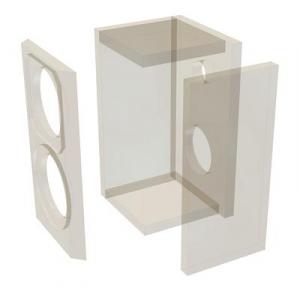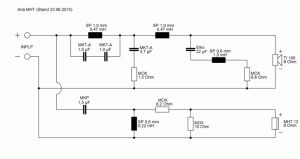ARIA MHT
Building instruction
Exploded drawing
Assembly
All the cabinet panels are cut from 16 mm chipboard or medium density fibreboard, butt-jointed and glued. After that, the openings for the driver and terminals are cut out and any necessary recesses cut. The chamfer on the outer baffle can be made either before the cabinet is glued together or afterwards.
Since the cabinets are relatively small, it is hardly possible to mount the crossover inside the housing. The PCB can, however, simply be wrapped in damping material and placed inside the speaker if the rear wall is not removable.
Inner damping
The damping material is loosely pushed into the cabinet. The space immediately behind the bass reflex tube must remain free.
Cabinet parts list for 1 box
Sketch
Crossover
Press
With its ARIA MHT, VISATON has blended its flagship tweeter and smaller mid-bass units to produce a highly attractive loudspeaker. (...)
Visaton's magnetostatic tweeter knew exactly how to make a good impression in all respects with its gentle, rounded, totally convincing resolution and clarity. The mid-range stood out particularly due to its clear, precise vocal rendition. It was simply fantastic. (...)
ARIA MHT is (...) a seductive little loudspeaker with an overall soundquality which, at volumes up to medium level, far exceeds the physical size of the unit.
From the start, the ARIA speakers make a convincing impression in the mid-range and reproduce voices unusually clearly. In connection with the silky smooth treble produced by the magnetostats, terms like "smooth" and "calming" automatically go through one's mind. What is really remarkable is the volume level achievable: the potential diaphragm excursion of the TI 100 is impressive.
“From the start, the ARIA speakers make a convincing impression in the mid-range and reproduce voices unusually clearly. In connection with the silky smooth treble produced by the magnetostats, terms like “smooth” and “calming” automatically go through one's mind. What is really remarkable is the volume level achievable: the potential diaphragm excursion of the TI 100 is impressive. Although the ARIA MHT produces powerful bass when used as a shelf speaker, it makes sense to add an active subwoofer if you need to emphasise the lowest frequencies.”
Grand Orgue / Petit Orgue (Klang & Ton 01/2011)
“Les Orgues” - two ambitious concepts that are well away from the mainstream and which are highly successful in practice. Emphasis is clearly on the lower-range frequencies which, thanks to the dipole technology, remain more clearly detectable, clear and deep than with other systems. The large diaphragm area of the full-range drivers supplements the bass to produce a rich, homogeneous whole, and results in total in loudspeakers that are both excellent and affordable and suited to any genre of music that would get hopelessly lost on small speakers.”
The differences between Grand Orgue & Petit Orgue:
“The Petit Orgue is a quarter the size of the Grand Orgue, but produces almost exactly the same readings (including depth of bass) and, mounted on a stand, is both visually and aurally a remarkable speaker. It is enough to take your breath away when you are sitting on your settee and watch this little box produce ultradeep bass of the most remarkable quality.” ... “in smaller rooms – in particular ones with bass production problems – this could be a real dream come true.”

